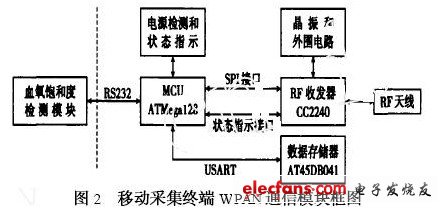Design of WPAN pulse oximeter
This article introduces a pulse oximeter based on wireless personal area network (WPAN) design. WPAN is a wireless transmission technology developed to establish a wireless connection between devices in a small area. The IEEE Standards Association has formulated the IEEE802.15.X standard for this purpose. The transmission technology involved in this article complies with the IEEE 802.15.4 (ZigBee) standard specifically formulated for low-speed WPAN.
1 System components and functions
The system structure of the pulse oximeter based on WPAN is shown in Figure 1.

The function of the mobile acquisition terminal of the detector: detect the blood oxygen saturation, pulse and pulse intensity of the human body, and transmit the data to the main station of the detection system through the WPAN communication module. The mobile acquisition terminal of the detector is divided into detection probe, blood oxygen saturation monitoring module, power supply and WPAN communication module. The detection probe and blood oxygen saturation detection module are outsourcing OEM modules, which are products of American BCI company. It uses photoelectric method and Beer's theorem to achieve non-invasive detection. The detector mobile collection terminal also supports an independent working mode, which is suitable for continuous non-real-time work.
The function of the main station of the detector: receive and store the information sent by the mobile collection terminal of the detector through the WPAN interface; display the real-time information or historical data from the mobile terminal on the display screen according to the operator's instructions; when the detection parameters exceed the threshold value The alarm signal is sent out; it can communicate with the supporting management system in the background through the fast Ethernet interface as needed to complete more complex management functions. One detector main station can be connected to multiple detector mobile collection terminals, which not only increases the convenience of use, but also improves the utilization rate of the main station and reduces the cost of the system. Except for the detection probe and the blood oxygen saturation detection module, the rest of the system is designed by itself, which will be introduced below.
2 Design and implementation of detector mobile acquisition terminal
The function of the WPAN communication module of the mobile acquisition terminal of the detector: receiving the command of the main station of the detector through the WPAN communication module, parsing the command, and issuing a control command to the blood oxygen saturation detection module through the RS2232 interface; receiving the collection of the blood oxygen saturation monitoring module The data and feedback control information are sent to the main station of the detector through the WPAN communication module after preprocessing and packaging.
2.1 Hardware design of the communication module of the mobile acquisition terminal of the detector
The hardware composition of the WPAN communication module of the mobile acquisition terminal of the detector is shown in Figure 2.

(1) Some functions and implementation of MCU
The MCU part is the core of the WPAN communication module, which completes the control, coordination and data processing of each component of the communication module. Specific functions: communicate with the blood oxygen saturation detection module through the RS232 interface, realize its control and configuration, and receive the detection data; realize the configuration and detection of the RF transceiver through the SPI interface and status indication interface, and complete the transmission and reception Data exchange; connect to the data storage through the USART interface to complete the read and write operations of the data storage; through the power supply detection and status indication section, monitor the power supply voltage situation, and can generate an alarm prompt through the status indication.
(2) Function and implementation of RF transceiver
The function of the RF transceiver is to realize wireless transmission and reception of data to be transmitted. Specific functions include: complete the data exchange with the MCU part through the SPI interface, the data content includes the data to be transmitted and the control and configuration information from the MCU part; adjust the relevant RF parameters according to the control and configuration information from the MCU; pass status and instructions The interface feeds back the transmission status to the MCU; completes the wireless transmission and reception of data through the antenna; completes the physical layer function of WPAN and realizes the protocol processing of the physical layer. This part is realized by Chipcon CC2420.
(3) Function and implementation of data storage
The function of the data memory is to buffer the collected data of the blood oxygen saturation detection module. Data buffering is mainly used when the wireless connection is unreliable. The data storage buffers the accumulated data when the wireless connection is not smooth and cannot complete the timely transmission of the collected data, so that the data can be transmitted when the data path is restored; another function of the data storage is to store the collected data when the mobile collection terminal is used offline. It is suitable for long-term non-real-time status tracking of the monitored objects.
The data memory is realized by ATMEL's new FLASH chip AT45DB041. When the mobile collection terminal works offline, the collected data is stored in the memory, and the data storage duration time is greater than 48h. If compression technology is used to store the data, the data storage duration is greater than 168h.
Pm Stepper Motor,Square Flange Stepper Motor,High Precision Stepper Motor,Permanent Magnet Stepper Motor
Changzhou Sherry International Trading Co., Ltd. , https://www.sherry-motor.com